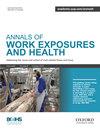1 在露天采矿中采用低成本传感器:定性评估工作场所暴露情况,以改善排放管理并降低风险
IF 1.8
4区 医学
Q3 PUBLIC, ENVIRONMENTAL & OCCUPATIONAL HEALTH
引用次数: 0
摘要
引言 空气质量和工作场所暴露都是露天采矿的重要考虑因素。监管工作通常包括在边界安装几个昂贵的参考监测器,评估每小时和每天的浓度,而工作场所的暴露则每年评估一到两次。控制相关的环境和健康风险通常由操作人员主观判断。低成本的便携式传感器可以作为这些方法的补充,以极低的成本提高空间和时间分辨率。方法 定制低成本自主装置。这些装置由太阳能供电,配有备用电池,可在几分钟内部署完毕。每个装置都能采样、求平均值并将数据发送到网关,数据可在在线仪表板上直观显示。在四个月的时间里,共部署了十多个传感器,并从矿场的不同区域收集了颗粒物数据。结果 安装简单,采样速度快,能够评估采矿活动附近的瞬时粉尘产生情况。不同区域的颗粒物浓度既有相似的时期,也有不同的时期,在某些情况下,两周的平均值相差四倍以上,而考虑到五分钟的短期数据,则相差十倍以上。结论 对现有的边界和个人颗粒物监测仪进行补充的实时系统证明是可行的。传感器网络可以提供更多的数据驱动决策,将主观性降至最低,并可集成到粉尘管理和行动计划中,从而减少因法规超标和职业风险而导致的运营停机时间。本文章由计算机程序翻译,如有差异,请以英文原文为准。
1 Implementation of low-cost sensors in open-cut mining: qualitative assessment of workplace exposure to improve emissions management and reduce risk
Introduction Air quality and workplace exposure are both important considerations in open-cut mining. Regulation typically involves a few expensive reference monitors located at the boundary, assessing hourly and daily concentrations while workplace exposure is assessed once or twice a year. Controlling associated environmental and health risks is typically instigated by subjective operator judgement. Low-cost, portable sensors can supplement these methods to increase both spatial and temporal resolution at a fraction of the cost. Methodology Bespoke low-cost autonomous units were built. The units are solar powered with battery backup and can be deployed in minutes. Each unit samples, averages and sends data to a gateway with the data visualised on an online dashboard. More than a dozen sensors were deployed, and particulate matter data collected from different areas of the mine, over a period of four months. Results Easy installation and quick sampling rate enabled assessment of instantaneous dust generation, in close vicinity to mining activity. Different areas showed periods of similar but also varying particulate matter concentrations, in some instances more than four times difference when averaged over two weeks and more than ten times when considering short-term, five-minute data. Conclusions A real-time system to supplement existing boundary and personal particulate matter monitors is demonstrated to work. The network of sensors can lead to more data-driven decision making with minimised subjectivity and can be integrated into a dust management and action plan that can reduce operational downtime due to regulatory exceedance and occupational risk.
求助全文
通过发布文献求助,成功后即可免费获取论文全文。
去求助
来源期刊

Annals Of Work Exposures and Health
Medicine-Public Health, Environmental and Occupational Health
CiteScore
4.60
自引率
19.20%
发文量
79
期刊介绍:
About the Journal
Annals of Work Exposures and Health is dedicated to presenting advances in exposure science supporting the recognition, quantification, and control of exposures at work, and epidemiological studies on their effects on human health and well-being. A key question we apply to submission is, "Is this paper going to help readers better understand, quantify, and control conditions at work that adversely or positively affect health and well-being?"
We are interested in high quality scientific research addressing:
the quantification of work exposures, including chemical, biological, physical, biomechanical, and psychosocial, and the elements of work organization giving rise to such exposures;
the relationship between these exposures and the acute and chronic health consequences for those exposed and their families and communities;
populations at special risk of work-related exposures including women, under-represented minorities, immigrants, and other vulnerable groups such as temporary, contingent and informal sector workers;
the effectiveness of interventions addressing exposure and risk including production technologies, work process engineering, and personal protective systems;
policies and management approaches to reduce risk and improve health and well-being among workers, their families or communities;
methodologies and mechanisms that underlie the quantification and/or control of exposure and risk.
There is heavy pressure on space in the journal, and the above interests mean that we do not usually publish papers that simply report local conditions without generalizable results. We are also unlikely to publish reports on human health and well-being without information on the work exposure characteristics giving rise to the effects. We particularly welcome contributions from scientists based in, or addressing conditions in, developing economies that fall within the above scope.
 求助内容:
求助内容: 应助结果提醒方式:
应助结果提醒方式:


